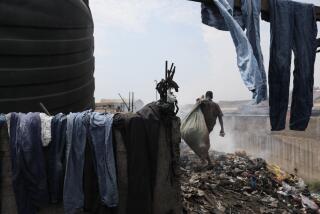Consumers: Ask retailers whether they subscribe to ‘No Sweat’ pact on clothing origins.
- Share via
This holiday shopping season has brought welcome news for many retailers as consumer confidence, buoyed by a growing economy, appears to have translated into record sales. Carefully crafted full-page ads and stylish store displays attract the buyer while avoiding any mention of the origin of the items for sale. It is easy for the shopper to be unaware that the apparel gifts being purchased for family or friends may have been sewn in a local sweatshop or imported from a country where clothing factories employ children in slave-like conditions.
Consumer awareness was given a boost last year when the Department of Labor issued its first Trendsetter List of retailers and apparel manufacturers that had agreed to monitor their contractors for federal labor law compliance. The department’s accompanying “bad guy list” exposed some of those in violation of federal wage laws.
The department estimates that many of the nation’s 22,000 sewing shops can be characterized as sweatshops with wage and hour violations, hazardous working conditions and even child labor. Workers may earn as little as 70 cents per hour, are typically paid by the piece and enjoy little job security. Health care coverage, sick leave and paid vacation are virtually nonexistent.
The U.N.’s International Labor Organization estimates that 100 million to 200 million children work, more than 95% of them in developing countries. Most of them work in agriculture, the service sector or in small-scale manufacturing, which includes the garment industry. Though a growing number of countries have child labor laws on the books, most of these children work in the informal economy, which keeps them hidden from public scrutiny.
This shopping season, a coalition of federal agencies, unions, religious organizations and community groups is urging Americans to be “No Sweat” shoppers by avoiding the purchase of sweatshop-made clothing. Consumers who are aware of the history of the garments they purchase are an essential component in the formula for ending sweatshop conditions and child labor.
Knowledge begins with the questions buyers ask. The Department of Labor suggests asking retailers questions such as: Where was the garment made? Do you independently monitor garment manufacturers to determine that they are not using sweatshop labor? Do you support “No Sweat” clothing?
The Trendsetter List can be helpful. These companies have voluntarily committed to enforce labor laws, to cooperate with government officials when labor violations are found and to monitor the working conditions of their suppliers and contractors. While purchasing from the list does not guarantee that the clothing items can be classified “No Sweat,” the odds are favorable.
Dollars can speak louder than words. So, by making educated purchases, consumers can support efforts to improve the lives of the working poor who labor in the garment industry. It’s “no sweat.”
More to Read
Inside the business of entertainment
The Wide Shot brings you news, analysis and insights on everything from streaming wars to production — and what it all means for the future.
You may occasionally receive promotional content from the Los Angeles Times.










